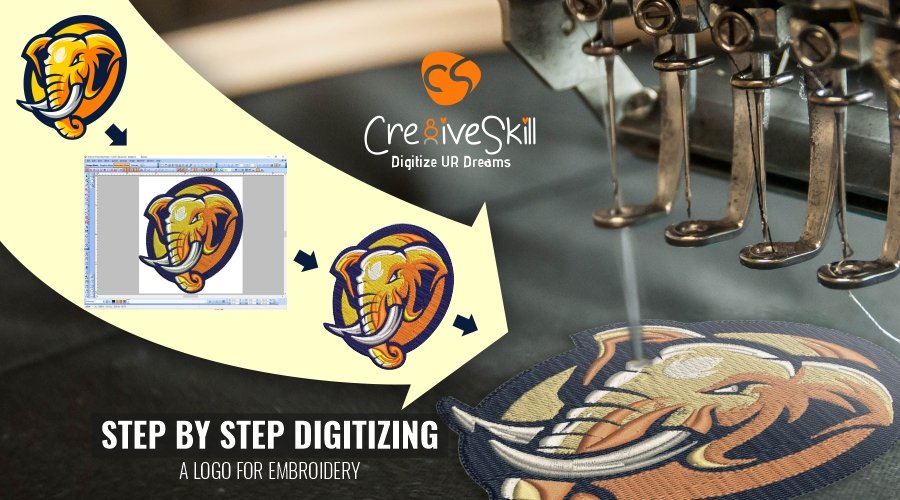Simplifying the Art of Needlework Digitizing: Step-by-Step Overview
Embroidery digitizing is a thorough craft that requires precision and creativity. As technology proceeds to development, the digitization process has become extra accessible, enabling enthusiasts to bring their detailed styles to life with convenience. In this guide, we will certainly unravel the intricacies of embroidery digitizing, damaging down each step carefully to streamline the procedure and equip both newbies and skilled embroiderers alike. Stay tuned to discover just how you can streamline this elaborate art kind and change your innovative visions into perfectly embroidered masterpieces.
Comprehending Needlework Digitizing Software
Needlework digitizing software program works as a vital tool for changing complex styles right into electronic styles compatible with needlework machines, promoting specific stitching and personalization. This customized software application permits users to import numerous image data formats, such as JPG or PNG, and convert them into needlework machine-readable styles like DST, EXP, or PES - Digitizing for Embroidery. By making use of attributes like stitch editing, rug options, and thread color choice, digitizing software application makes it possible for users to control every facet of the layout procedure
Additionally, progressed embroidery digitizing software application supplies tools for developing complicated designs, readjusting stitch thickness, and integrating complex details. Individuals can likewise sneak peek the style before sewing it out, ensuring precision and minimizing errors. In addition, many software application provide automated features that assist simplify the digitizing process, saving effort and time.
Recognizing the capabilities of embroidery digitizing software program is vital for attaining top quality outcomes in needlework tasks. By understanding this tool, embroidery lovers and professionals can release their creativity and bring detailed layouts to life with accuracy and efficiency.

Selecting the Right Style File
After familiarizing on your own with the capacities of embroidery digitizing software application, the following critical step in the process is picking the ideal layout file for your project. Digitizing for Embroidery. When selecting a design documents for embroidery digitizing, it's vital to think about the complexity of the layout, the size of the last item, and the kind of textile you will certainly be dealing with
For elaborate layouts with great information, a high-resolution image or vector data is recommended to make certain that the needlework machine can accurately recreate the design. Additionally, the size of the final product plays a considerable duty in selecting the ideal style file. Bigger styles might require greater resolution files to keep clarity and intensity.
In addition, the kind of textile you will be embroidering on affects the option of design file. Different fabrics might need adjustments in the style file to make sure that the stitches are effectively straightened and the style shows up as intended. read the article By thoroughly selecting the best style documents based upon these aspects, you can set yourself up for an effective needlework digitizing procedure.
Digitizing Tools and Methods
Making use of specialized software and precision strategies, digitizing tools are vital in changing intricate styles right into embroidery-ready files. Needlework digitizing software application, such as Wilcom, Hatch, or Embrilliance, provides the necessary system to convert artwork into stitch information. These programs supply attributes like stitch editing and enhancing, padding choices, and lettering tools to make sure the layout converts seamlessly onto textile.
One of the key strategies in digitizing is developing a clear course for the embroidery maker to adhere to. This involves digitizing each component of the style with precision, determining stitch kinds, densities, and directions. By making use of devices like digitizing tablets or software-specific plugins, embroiderers can accomplish a high level of accuracy in their digitized layouts.
Additionally, grasping the art of padding sewing is crucial for producing top quality needlework. Underlay sewing maintains the textile and develops a structure for the style, making certain that the final product is both aesthetically enticing and long-lasting. By understanding these digitizing tools and strategies, embroiderers can elevate their craft and bring complex layouts to life with precision and performance.
Customizing Stitch Kinds and Instructions
The choice of stitch kinds can significantly affect the general appearance and appearance of the embroidered layout. By strategically integrating these stitch kinds, embroiderers can accomplish deepness and dimension in their styles.
Furthermore, the instructions of stitches plays an important role in boosting the visual allure my latest blog post of the final needlework. Numerous stitch directions can include structure, emphasize certain elements, and develop visual passion. Changing the angle of stitches can imitate motion or natural patterns like hair or feathers. By try out various stitch angles and patterns, embroiderers can bring their styles to life with remarkable information and complexity. Understanding the art of customizing stitch types and instructions equips embroiderers to release their imagination and elevate the high quality of their job.
Testing and Refining Your Digitized Style
To make certain the accuracy and high quality of your digitized layout, extensive screening and refinement are crucial steps in the needlework digitizing process. When you have completed the digitization of your design, it is vital to evaluate it before continuing with the real embroidery. Evaluating allows you to recognize any kind of possible problems such click to read as thread breaks, stitch thickness troubles, or style distortions that might impact the result.

After testing, it is necessary to improve your digitized design based upon the feedback from the examination sew-out. This might entail tweaking stitch settings, readjusting densities, or making modifications to the general layout to achieve the preferred result. By repeating via testing and improvement, you can fine-tune your digitized design to perfection before progressing with the real needlework procedure.
Conclusion
In conclusion, grasping the art of embroidery digitizing calls for a thorough understanding of the software program, selecting the best layout documents, using digitizing tools and strategies, personalizing stitch types and directions, and screening and fine-tuning the digitized design. By adhering to these actions, embroiderers can streamline the digitizing procedure and create high-grade embroidered designs with accuracy and efficiency.